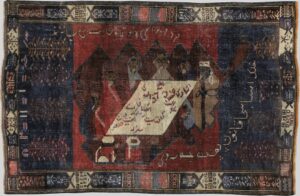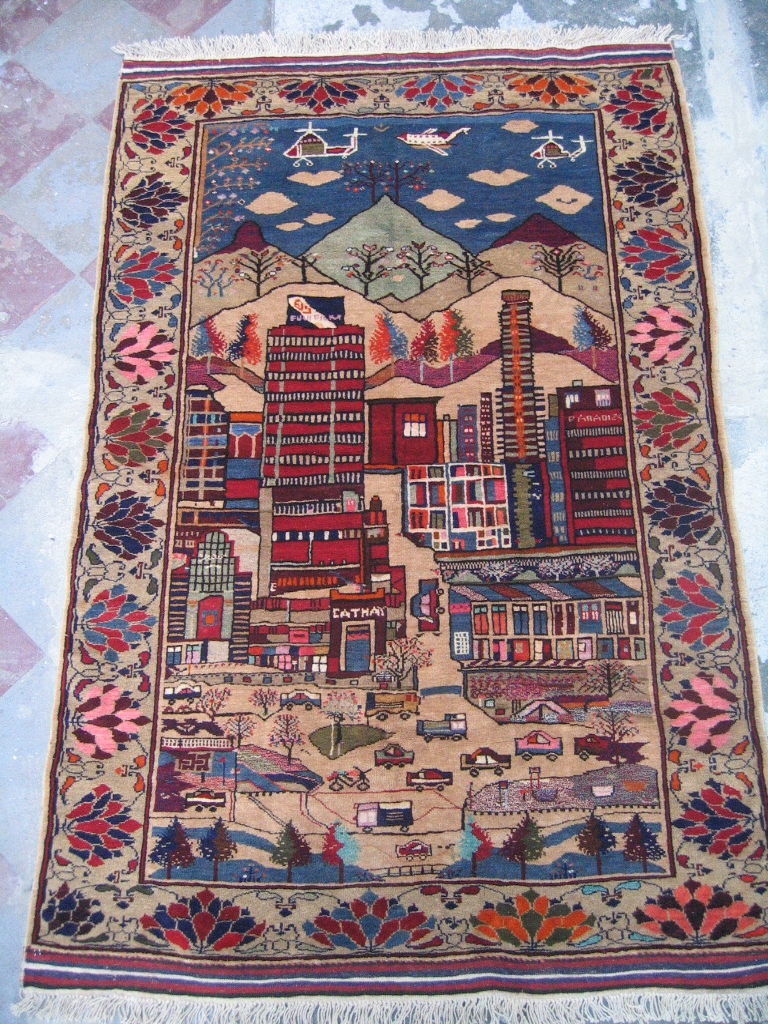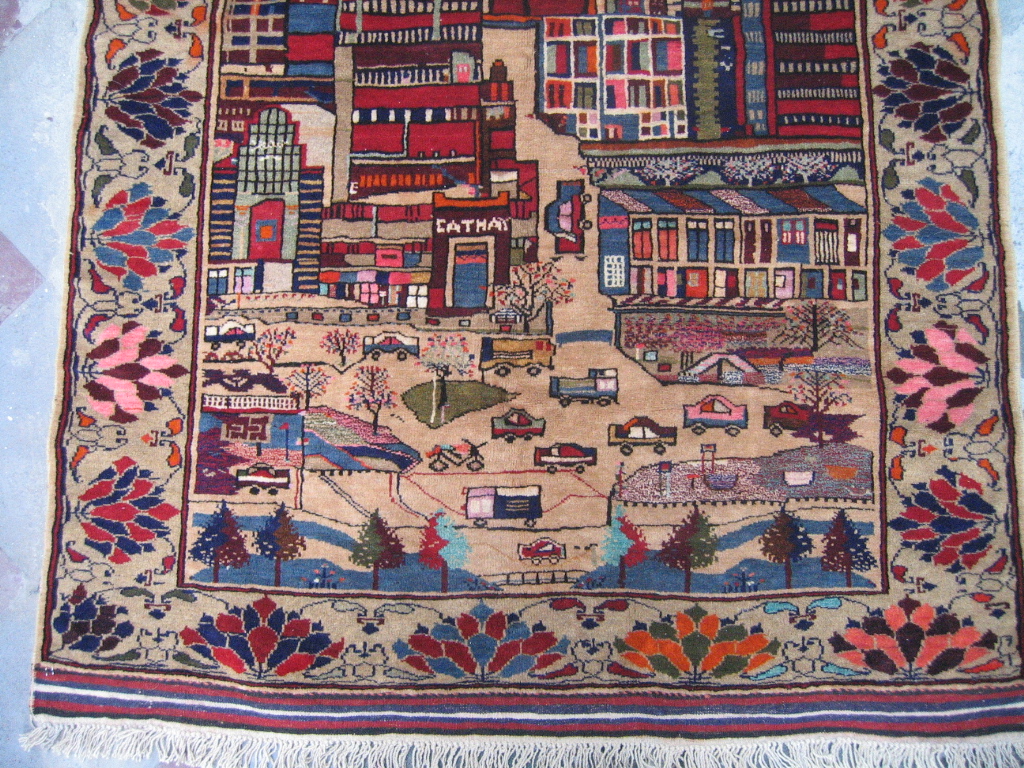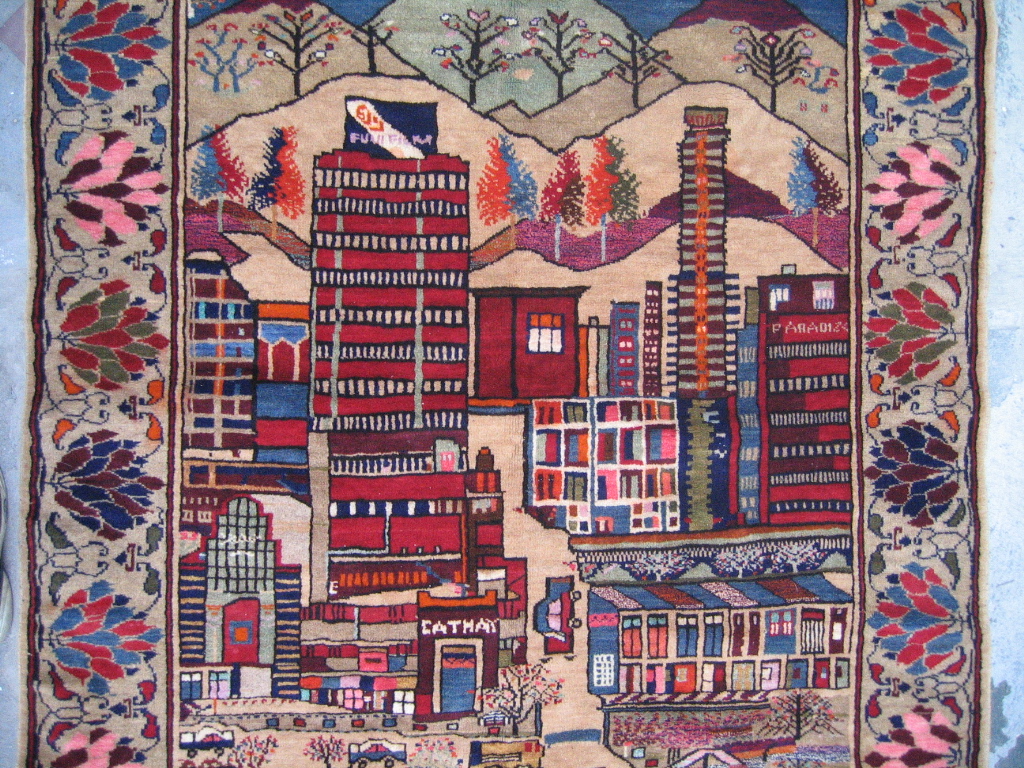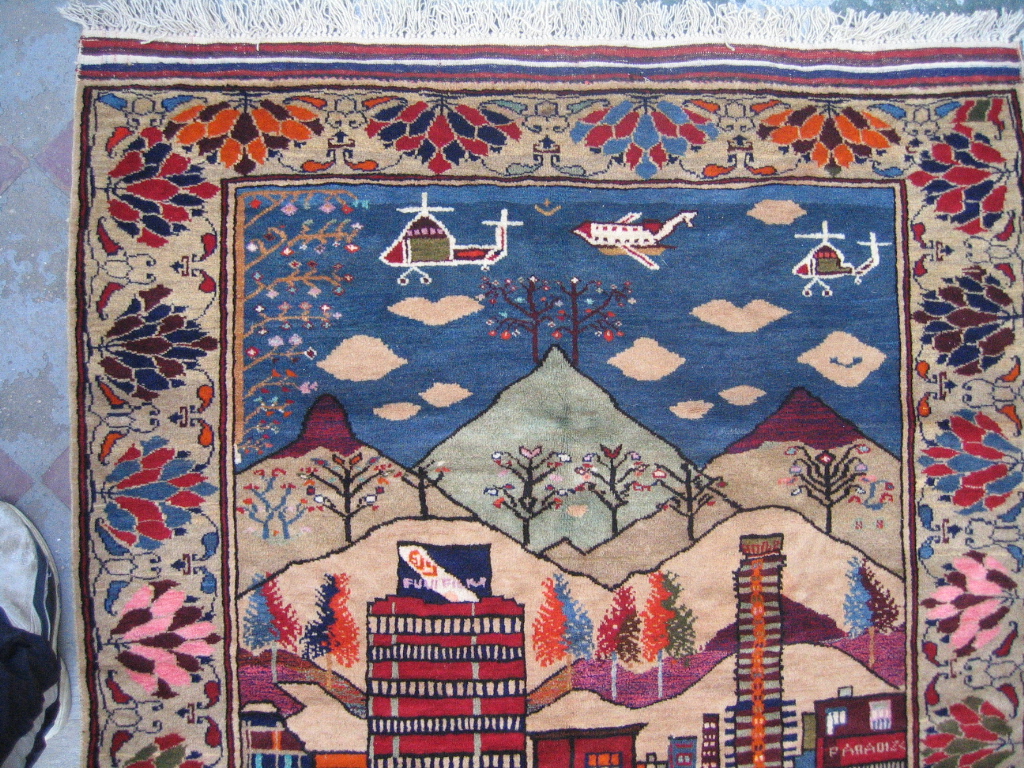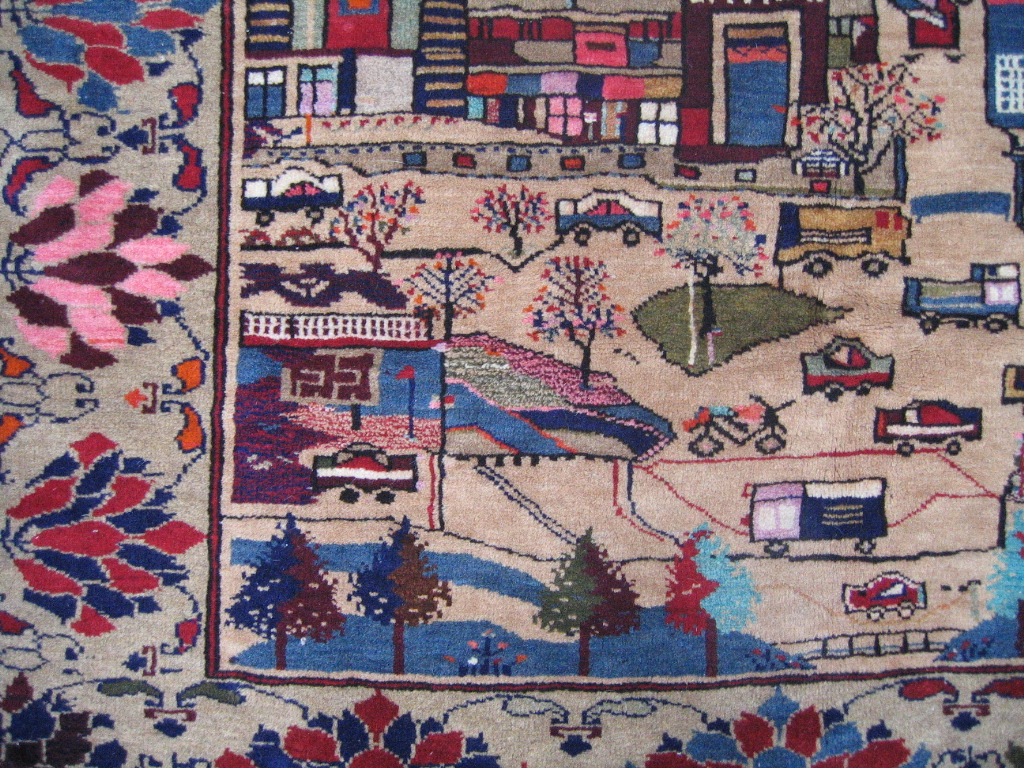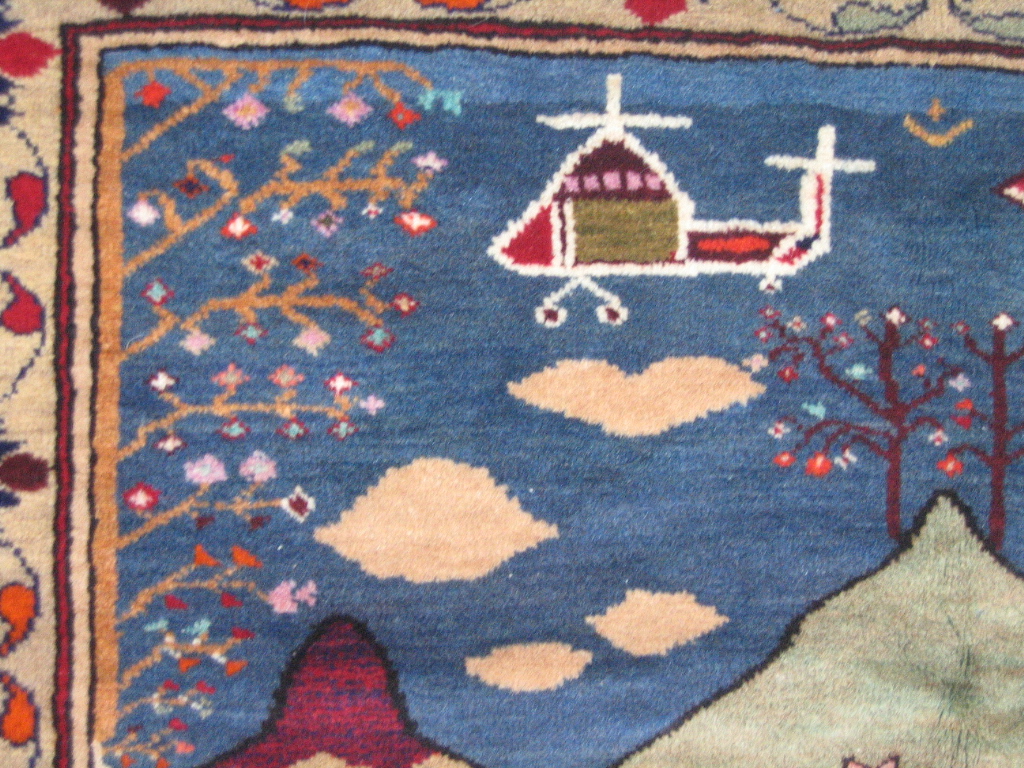Here is a rug of a rare and important design. It shows the forging of the Afghan constitution during the country’s democratic moment It is for sale by friend, so contact me for the details.
Category Archives: Rug Images
Blue Elephant Foot Bokara Drone War Rug
This rug is woven of excellent, hand-spun wool and features vegetable dye colors. The rug employs a classic Bokara or Elephants Foot design (like this antique non-war rug), but rather than traditional tribal emblems this rug uses a major and minor guls made from drones.
The size is Size 78 x 117 inches (198 X297 cm) and it can be purchased on warrug.com after clicking on Drone War Rugs.
UXO Rugs Woven in Afghanistan
The UXO, a.k.a. Unexploded Ordnance, rugs were all woven in Afghanistan between 2002 and August 2021 and given the sanctions / embargo, there will be no more for the foreseeable future
They are inspired by older UXO rugs like the UXO warning rug and the Weapon Inventory War Rug. The new UXO rugs came in two sizes (5×8 feet or 1.5M x 2.5M and 6’6″x12’6″ or 2x4M) and made out of the “Chobi” wool is high quality wool, minimally processed then spun by hand.
The rugs feaature life sized UXO.
UXO Rugs
Unexploded Ordnance, a.k.a. UXO, Rug . Between 2002 and August 2021 these UXO rugs have been woven in Afghanistan and will be the last for the foreseeable future. They are life sized images and for sale in these sizes 5×8 feet or 1.5M x 2.5M and 6’6″x12’6″ or 2x4M here
UXO Rugs, a.k.a Unexploded Ordnance
UXO stands for Unexploded Ordnance there are a number of examples on the site some older like the Unexploded Ordinance Warning Rug and some which are still for sale and newer. Check out the Turkmen and Uzbek War Rug with Light Fields.
Sometimes these rugs come with a message like the UXO warning rug which says “do not touch or play with, these are very dangerous” in both Farsi and Pashto, the “unexploded” element creating a lasting impression of suspense.
The Turkmen and Uzbek UXO rug is done in the “Chobi” or “Vegetal Dye Peshawar” style with Turkmen borders. It is exceptionally beautiful.
Luca Emilio Brancati’s uniquely important collection
My understanding is that Luca Emilio Brancati collected war rugs from 1984 until 1987 exclusively. Thanks to Nigel Lendon, I saw a few photos over the years, but documentation of Brancati’s important 2018 exhibition at the gallery in the Palazzo Lascaris in Turin, Italy, was the first time good photos were published on the internet.




More rare photos are here, and on this FB post, and press coverage is here, and an announcement is here.
Brancati’s pinterest has lots of interesting war rug photos.
In Brancati’s new book with Amedeo Vittorio Bedini the photos alone are surely worth the thirty-four Euros.
Brancati’s last book was also a fascinating subject. Published in 1999 it seems to be out of print, but The Carpets of the Painters (or I Tappeti dei Pittori), analyzes rugs shown in old paintings.
Cityscape in Springtime Rug
This is a rug that was sold before being properly inventoried, and recently I found these photos from 2004. If you happened to have bought this rug from me at the showroom in Long Island City, please contact me, for it would be good to get better quality photos.
What makes this rug so great? First, its depiction of spring in a city. The colors are lively and fresh. Second, it is a well drawn and clear Modern City Landscape, and maybe a key to identifying the location. Third, the drawing is very good with wonderful details: the plane, the motorcycle, the blooming trees. Fourth, the border is festive with strong rhythm. Enjoy!
That Rug Really Tied the Room Together, Did it Not?
Warrug.com gets a lot of traffic, but what was the most viewed file in September 2018? A blog post from 2006 about regular rugs we were selling at the flea market entitled contained one photo that has achieved an obscure internet fame. The Mashad rug we were selling looked just like the rug which The Dude took of the Big Lubowoski (and Maude stole back.)
Well here it is again:
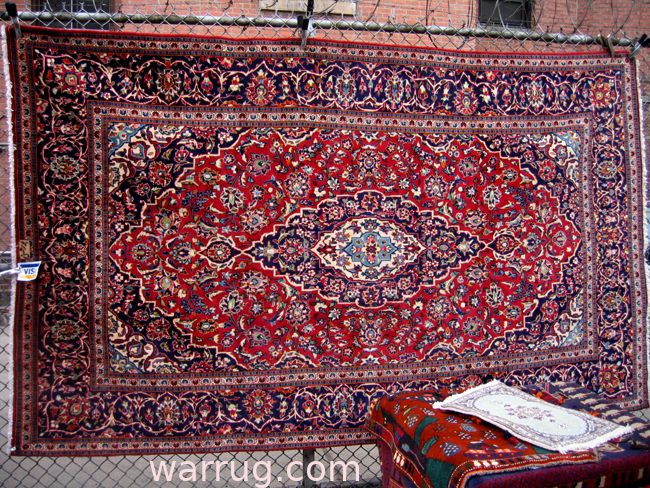
Funny thing is, I do not know who is using the photo, or where on the internet is posted.
Artsy Story about War Rugs, Boetti, and Leah Dixon
Vanessa Thill wrote an an interesting piece about war rugs for Artsy. which reaffirms Alighiero Boetti’s influence on world map rugs.

Alighiero Boetti, Mappa, 1983-1984
Tornabuoni Art
Despite decades of war, ancient pattern techniques that can take months or years to complete are still passed from mother to daughter. Testimony from the makers of these carpets is difficult to obtain, as many of these works remain unattributed, and the female weavers lack easy access to modes of international communication. But the largest online archive of Afghan war rugs, maintained by New York–based artist Kevin Sudeith, offers information and an online store. Still, the weavers’ authorship is often lost when these works go to market, yet their masterful compositions reveal a dark humor and complex commentary on contemporary life.
In the carpets’ compositions, perspectival viewpoints merge and flatten to integrate three-dimensional forms with maps and repeating decorative patterns. Some of the rug designs are based on Charbagh, a quadrilateral layout inspired by the four gardens of Paradise described in the Qur’an. Another genre of rugs depicts national maps of Afghanistan, which may have been influenced by Alighiero Boetti’s map series.The Italian Conceptual artist traveled to Afghanistan and Pakistan in the 1980s and worked with female weavers, first in Kabul and later in Peshawar, to create brightly colored tapestries depicting world maps with national flags labeled with bold text. In keeping with his interest in chance, Boetti sometimes left the color choices up to the women.
….
Because many artists shy away from this touchy subject matter, Dixon found unlikely peers in the anonymous rug weavers. The horrors of violence and the destruction of everyday life manifests in these carpets with an absurd levity. Dixon first created her own version in 2010—not woven but cut from colorful yoga mats. She described the work as an homage to the carpet weavers—and a jab at the United States’s commercialized relationship to war.

Leah Dixon, Don’t See a Need for Middlemen I, 2017–19.
Drone Rug in NY Times Opinion Piece
Opinion: The Secret Death Toll of America’s Drones
The Pentagon says American airstrikes in Somalia have killed no civilians since President Trump accelerated attacks against Shabab militants there two years ago.
Amnesty International investigated five of the more than 100 strikes carried out in Somalia since 2017 by drones and manned aircraft, and in just that small sampling found that at least 14 civilians were killed.
The Pentagon says airstrikes by the American-led coalition fighting the Islamic State killed at least 1,257 civilians in Iraq and Syria as of the end of January.
Airwars, a university-based monitoring group, estimates that those strikes killed at least 7,500 civilians in those countries.
Those disparities show how poorly the American public understands the human cost of an air war fought largely by remote-controlled drones. Drones have been the main weapon in the counterterrorism fight for more than a decade. They kill extremists without risking American lives, making combat seem antiseptic on the home front. But the number of civilians killed in these attacks is shrouded in secrecy.
